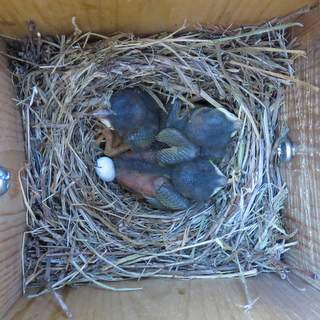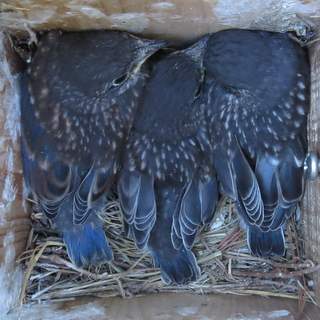I first created this site back in 1998 to document the wild plants that I encountered. But it has grown into a clearinghouse of information on landscaping, backyard birds, butterfly gardening, plant identification and making paper from plant fiber. After leaving Kansas, I thought of deleting the site. But realize it has a wealth of information that people rely upon.
Hosting the site is involved. I’d like to thank those who have donated to help defray the web site hosting fees. If you would like to contribute, please click the Donate button. Thank you.
Eastern Bluebird
Eastern Bluebird Topics
- About Eastern Bluebirds
- Feeding Bluebirds
- Bluebird Nest Boxes
- Mounting Bluebirds Nest Boxes
- Starling/House Sparrow Competition
- Bluebird Nesting Attempts
About Eastern Bluebirds
Eastern bluebirds are Cavity Nesting Birds. They will nest in tree cavities or in nest boxes (aka bird houses). Bluebirds are very well adapted to backyards with short vegetation and scattered trees. They hunt insects from a perch, flying to the ground to capture their prey. If you want to attract bluebirds to nest in your yard, put up a Nest Box designed for bluebirds. Besides putting up a nest box, you will need to control House Sparrows as they will prevent bluebirds from nesting.
Playlist of Eastern Bluebird Videos
Feeding Bluebirds
Bluebirds do not eat seeds so you won't see them at your seed feeders.
They will eat mealworms. They especially like live mealworms but they can be expensive. I've had them eat dried mealworms on occasion but other birds usually find them and eat them all before the bluebirds find them.
Some people have luck with them eating suet but I've not had them eat it.
Providing a water source is probably a better way to attract them than providing artificial food.
Nest Box for Eastern Bluebirds
Putting up a nest box for bluebirds may entice them to nest.
But putting up a nest box will more than likely also attract both house sparrows, introduced invasive species. Before you decide to put up a nest box for bluebirds, you must commit to preventing house sparrows from nesting in your nest box. They will destroy the eggs, nestlings and adult bluebirds, given the chance.
If you are ready to control house sparrows, then you will need some nest boxes. Various literature recommends a 4 to 5 inch square box. Based on my experience, I find a 3 1/2" X 4" box works well. It uses pine boards, which are smooth on all surfaces. The box uses a front opening design and allows for nest box traps to be inserted. A Nest Box Trap should be used to trap competing house sparrows.
The dimensions of a nest box are as follows.
- Sides: 1" x 6" finished board, 10" long (actual board dimension is 3/4" x 5 1/2")
- Front & Back: 1" x 4" finished board, 10" long (actual board dimension is 3/4" x 3 1/2")
- Base: 3 1/2" x 4"
- Hole: 1-1/2" diameter
Nest Box Design gives detailed information on building this nest box as well as others.
I'd suggest erecting more than one nest box as the extra nest boxes can be used to trap the invasive house sparrows and may attract other native nesting birds such as tree swallows.
Once your nest boxes are built, you need to mount them. The mounting method is as important as the nest box itself.
Mounting a Bluebird Nestbox
Bluebirds prefer a nest box that is mounting at 5' to 10' high in an open area with few to no trees. A 10' high mounting is prefered by the birds as it is safer from predators. A nest box mounted at 5' will work well in landscapes where the surrounding vegetation is kept short. But where vegetation is taller, a 10' mounting is your best bet.
The method of mounting your bluebird nest box is as important as the design of the nest box. Mounting to a tree or wood post is not a good idea, as predators will be given easy access to the box. Furthermore a nest box mounted on a tree is difficult and dangerous to monitor.
A much better technique is to mount the box on a telescoping pole. This allows the box to be be easily monitored.
It's important to locate the nest box in an open area with a clear flight path to the box. Do not mount it in an area with tree limbs that overhang the nest box either as that gives predators another point of access.
Bluebirds are birds of open country. Do not mount nest boxes in wooded areas.
Mounting Nest Boxes gives detailed methods for mounting nest boxes.
House Sparrow Control
The House Sparrow is an invasive non-native bird species that compete negatively with our cavity nesting native birds for nest sites. Like the bluebird, they are a cavity nesting bird.
They are not protected in North America. They can be trapped and eliminated legally.
They will destroy the nests and nestlings of bluebirds as well as other native cavity nesting birds. Even if they don't destroy the nest, they will drive the nesting bluebirds away from their nest.
House Sparrow Control details methods of trapping house sparrows.
You must commit to trapping house sparrows to prevent them from competing with bluebirds and other native cavity nesting birds.
Eastern Bluebird Feeding Babies
After years of house sparrows preventing my bluebirds from nesting, I finally purchased a Nest Box Trap to catch the house sparrow male. House Sparrows are not native to North America and compete aggressively with our native birds. Once I trapped the house sparrow, the bluebirds started nest building that same day.This video shows the male feeding the babies.
Eastern Bluebird Nest Building
This is the second nesting for bluebirds in my yard in 2013. Their first nesting was about 60 feet away in another nest box. Again, I have been trapping House Sparrows, a non-native unprotected species. Watch as the female makes multiple trips to the nest box. She is gathering grass clippings that I have scattered in my vegetable garden. The male follows her as she gets the material, and follows her to watch over her as she enters the nest box. I especially enjoy listening to the singing house wren in the background of this video.
2016 Nestlngs
It is truly amazing to see the progression of a nest from eggs to fledging bluebirds. This was a second brood.
 Eastern Bluebird nestling (Jun 23)
Eastern Bluebird nestling (Jun 23) Eastern Bluebird nestlings (Jun 26)
Eastern Bluebird nestlings (Jun 26) Eastern Bluebird nestlings (Jun 29)
Eastern Bluebird nestlings (Jun 29) Eastern bluebird nestlings (July 2)
Eastern bluebird nestlings (July 2) Eastern Bluebird nestlings (Jul 5)
Eastern Bluebird nestlings (Jul 5) Eastern Bluebird nestlings (Jul 9)
Eastern Bluebird nestlings (Jul 9)DISCLAIMER: This page contains affiliate links in the right hand panel, which means that if you click on one of the product links, I’ll receive a small commission. This helps support my website and allows me to continue to add new content. Thank you for the support!
